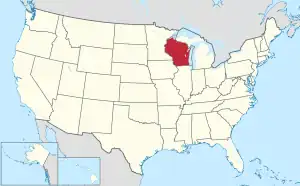Ashland County | |
|---|---|
 | |
 Location within the U.S. state of Wisconsin | |
 Wisconsin's location within the U.S. | |
| Coordinates: 46°43′N 90°34′W / 46.71°N 90.56°W | |
| Country | |
| State | |
| Founded | March 27, 1860 |
| Named for | Henry Clay's farm Ashland |
| Seat | Ashland |
| Largest city | Ashland |
| Area | |
| • Total | 2,292 sq mi (5,940 km2) |
| • Land | 1,045 sq mi (2,710 km2) |
| • Water | 1,247 sq mi (3,230 km2) 54% |
| Population | |
| • Total | 16,027 |
| • Density | 15.3/sq mi (5.9/km2) |
| Time zone | UTC−6 (Central) |
| • Summer (DST) | UTC−5 (CDT) |
| Congressional district | 7th |
| Website | www |
Ashland County is a county located in the U.S. state of Wisconsin. As of the 2020 census, the population was 16,027.[1] Its county seat is Ashland.[2] The county was formed on March 27, 1860, from La Pointe County.[3] The county partly overlaps with the reservation of the Bad River Band of the Lake Superior Tribe of Chippewa Indians.
History
Ashland County was named in honor of the Lexington estate of Kentucky statesman Henry Clay, as one of the founders of the city of Ashland was an admirer of Clay.[4][5]
Geography
According to the U.S. Census Bureau, the county has a total area of 2,292 square miles (5,940 km2), of which 1,045 square miles (2,710 km2) is land and 1,247 square miles (3,230 km2) (54%) is water.[6] It is the second-largest county in Wisconsin by total area. The Apostle Islands are a small group of islands in Lake Superior, off the Bayfield Peninsula with the majority of the islands located in Ashland County — only Sand, York and Raspberry Islands are in Bayfield County.
Adjacent counties
- Iron County – east
- Price County – southeast
- Sawyer County – southwest
- Bayfield County – northwest
- Lake County, Minnesota – northwest
- Cook County, Minnesota – north
- Ontonagon County, Michigan – northeast
- Gogebic County, Michigan – northeast
Major highways
Railroads
Buses
Airports
- John F. Kennedy Memorial Airport (KASX) serves the county and surrounding communities.
- Major Gilbert Field Airport (4R5) enhances county service.
National protected area
Demographics
| Census | Pop. | Note | %± |
|---|---|---|---|
| 1860 | 515 | — | |
| 1870 | 221 | −57.1% | |
| 1880 | 1,559 | 605.4% | |
| 1890 | 20,063 | 1,186.9% | |
| 1900 | 20,176 | 0.6% | |
| 1910 | 21,965 | 8.9% | |
| 1920 | 24,538 | 11.7% | |
| 1930 | 21,054 | −14.2% | |
| 1940 | 21,801 | 3.5% | |
| 1950 | 19,461 | −10.7% | |
| 1960 | 17,375 | −10.7% | |
| 1970 | 16,743 | −3.6% | |
| 1980 | 16,783 | 0.2% | |
| 1990 | 16,307 | −2.8% | |
| 2000 | 16,866 | 3.4% | |
| 2010 | 16,157 | −4.2% | |
| 2020 | 16,027 | −0.8% | |
| U.S. Decennial Census[7] 1790–1960[8] 1900–1990[9] 1990–2000[10] 2010[11] 2020[1] | |||
2020 census
As of the census of 2020,[1] the population was 16,027. The population density was 15.3 inhabitants per square mile (5.9/km2). There were 9,407 housing units at an average density of 9.0 units per square mile (3.5 units/km2). The racial makeup of the county was 79.8% White, 13.0% Native American, 0.7% Black or African American, 0.5% Asian, 0.1% Pacific Islander, 0.3% from other races, and 5.6% from two or more races. Ethnically, the population was 2.4% Hispanic or Latino of any race.
2010 census
As of the 2010 United States Census, there were 16,157 people living in the county. 84.6% were White, 11.1% Native American, 0.4% Asian, 0.3% Black or African American, 0.3% of some other race and 3.3% of two or more races. 1.9% were Hispanic or Latino (of any race). 25.6% were of German, 7.6% Finnish, 6.8% American, 6.5% Irish and 5.3% Norwegian ancestry.[12]
2000 census

As of the census[13] of 2000, there were 16,866 people, 6,718 households, and 4,279 families living in the county. The population density was 16 people per square mile (6.2 people/km2). There were 8,883 housing units at an average density of 8 units per square mile (3.1 units/km2). The racial makeup of the county was 87.10% White, 0.21% Black or African American, 10.35% Native American, 0.31% Asian, 0.05% Pacific Islander, 0.29% from other races, and 1.69% from two or more races. 1.11% of the population were Hispanic or Latino of any race. 27.8% were of German, 8.4% Finnish, 7.4% Polish, 7.4% Norwegian, 7.3% Swedish and 5.4% Irish ancestry. 96.6% spoke English as their first language. The reservation of the Bad River Chippewa Band is partially located in the county.
There were 6,718 households, out of which 30.30% had children under the age of 18 living with them, 48.60% were married couples living together, 10.90% had a female householder with no husband present, and 36.30% were non-families. 30.80% of all households were made up of individuals, and 14.40% had someone living alone who was 65 years of age or older. The average household size was 2.39 and the average family size was 3.01.
In the county, the population was spread out, with 25.40% under the age of 18, 11.20% from 18 to 24, 25.80% from 25 to 44, 21.70% from 45 to 64, and 15.90% who were 65 years of age or older. The median age was 37 years. For every 100 females there were 97.10 males. For every 100 females age 18 and over, there were 91.10 males.
In 2017, there were 194 births, giving a general fertility rate of 73.1 births per 1000 women aged 15–44, the eleventh highest rate out of all 72 Wisconsin counties.[14] Additionally, there were no reported induced abortions performed on women of Ashland County residence in 2017.[15]
Communities


Cities
- Ashland (county seat; partly in Bayfield County)
- Mellen
Village
Towns
Census-designated places
Unincorporated communities
Politics
Ashland County is consistently Democratic. It has voted for the Democrat in every presidential election since 1932, with the exceptions of 1952 and 1956 when it backed Republican Dwight D. Eisenhower's two successful bids for the presidency.
| Year | Republican | Democratic | Third party | |||
|---|---|---|---|---|---|---|
| No. | % | No. | % | No. | % | |
| 2020 | 3,841 | 43.86% | 4,801 | 54.82% | 115 | 1.31% |
| 2016 | 3,303 | 41.12% | 4,226 | 52.61% | 503 | 6.26% |
| 2012 | 2,820 | 33.68% | 5,399 | 64.49% | 153 | 1.83% |
| 2008 | 2,634 | 30.72% | 5,818 | 67.86% | 122 | 1.42% |
| 2004 | 3,313 | 36.01% | 5,805 | 63.10% | 81 | 0.88% |
| 2000 | 3,038 | 38.50% | 4,356 | 55.21% | 496 | 6.29% |
| 1996 | 1,863 | 27.41% | 3,808 | 56.02% | 1,127 | 16.58% |
| 1992 | 2,372 | 28.26% | 4,213 | 50.20% | 1,808 | 21.54% |
| 1988 | 2,926 | 39.11% | 4,526 | 60.49% | 30 | 0.40% |
| 1984 | 3,517 | 42.54% | 4,680 | 56.60% | 71 | 0.86% |
| 1980 | 3,262 | 37.56% | 4,469 | 51.46% | 954 | 10.98% |
| 1976 | 3,045 | 38.25% | 4,688 | 58.89% | 228 | 2.86% |
| 1972 | 3,478 | 46.93% | 3,771 | 50.88% | 162 | 2.19% |
| 1968 | 2,557 | 35.74% | 4,147 | 57.96% | 451 | 6.30% |
| 1964 | 2,198 | 28.96% | 5,383 | 70.91% | 10 | 0.13% |
| 1960 | 3,470 | 42.70% | 4,644 | 57.14% | 13 | 0.16% |
| 1956 | 4,121 | 52.70% | 3,677 | 47.03% | 21 | 0.27% |
| 1952 | 4,451 | 53.50% | 3,828 | 46.01% | 41 | 0.49% |
| 1948 | 3,135 | 41.75% | 4,110 | 54.73% | 264 | 3.52% |
| 1944 | 3,183 | 40.60% | 4,609 | 58.80% | 47 | 0.60% |
| 1940 | 3,592 | 38.59% | 5,586 | 60.01% | 131 | 1.41% |
| 1936 | 2,439 | 28.10% | 5,904 | 68.01% | 338 | 3.89% |
| 1932 | 2,646 | 31.77% | 5,405 | 64.90% | 277 | 3.33% |
| 1928 | 3,639 | 49.36% | 3,570 | 48.43% | 163 | 2.21% |
| 1924 | 2,272 | 32.44% | 449 | 6.41% | 4,283 | 61.15% |
| 1920 | 4,005 | 70.94% | 1,081 | 19.15% | 560 | 9.92% |
| 1916 | 1,998 | 51.98% | 1,582 | 41.16% | 264 | 6.87% |
| 1912 | 937 | 26.83% | 1,451 | 41.54% | 1,105 | 31.63% |
| 1908 | 2,259 | 54.21% | 1,582 | 37.96% | 326 | 7.82% |
| 1904 | 3,406 | 71.40% | 1,004 | 21.05% | 360 | 7.55% |
| 1900 | 3,034 | 63.97% | 1,557 | 32.83% | 152 | 3.20% |
| 1896 | 2,738 | 59.70% | 1,743 | 38.01% | 105 | 2.29% |
| 1892 | 2,283 | 46.46% | 2,436 | 49.57% | 195 | 3.97% |
See also
References
- 1 2 3 4 "2020 Decennial Census: Ashland County, Wisconsin". data.census.gov. U.S. Census Bureau. Retrieved July 11, 2022.
- ↑ "Find a County". National Association of Counties. Archived from the original on May 31, 2011. Retrieved June 7, 2011.
- ↑ "Wisconsin History: La Pointe County (obsolete)". Archived from the original on June 11, 2011. Retrieved September 20, 2008.
- ↑ Wisconsin Historical Society. "Term: Ashland County [origin of place name]". Dictionary of Wisconsin History. Archived from the original on June 11, 2011. Retrieved April 26, 2009.
- ↑ "Here's How Iron Got Its Name". The Rhinelander Daily News. June 16, 1932. p. 2. Retrieved August 24, 2014 – via Newspapers.com.

- ↑ "2010 Census Gazetteer Files". United States Census Bureau. August 22, 2012. Retrieved August 2, 2015.
- ↑ "U.S. Decennial Census". United States Census Bureau. Retrieved August 2, 2015.
- ↑ "Historical Census Browser". University of Virginia Library. Retrieved August 2, 2015.
- ↑ Forstall, Richard L., ed. (March 27, 1995). "Population of Counties by Decennial Census: 1900 to 1990". United States Census Bureau. Retrieved August 2, 2015.
- ↑ "Census 2000 PHC-T-4. Ranking Tables for Counties: 1990 and 2000" (PDF). United States Census Bureau. April 2, 2001. Archived (PDF) from the original on October 9, 2022. Retrieved August 2, 2015.
- ↑ "State & County QuickFacts". United States Census Bureau. Archived from the original on August 6, 2011. Retrieved January 17, 2014.
- ↑ "American FactFinder"
- ↑ "U.S. Census website". United States Census Bureau. Retrieved May 14, 2011.
- ↑ "Annual Wisconsin Birth and Infant Mortality Report, 2017 P-01161-19 (June 2019): Detailed Tables". Archived from the original on June 19, 2019. Retrieved June 19, 2019.
- ↑ Reported Induced Abortions in Wisconsin, Office of Health Informatics, Division of Public Health, Wisconsin Department of Health Services. Section: Trend Information, 2013-2017, Table 18, pages 17-18
- ↑ Leip, David. "Dave Leip's Atlas of U.S. Presidential Elections". uselectionatlas.org. Retrieved November 9, 2020.
External links
- Ashland County
- Ashland County map from the Wisconsin Department of Transportation